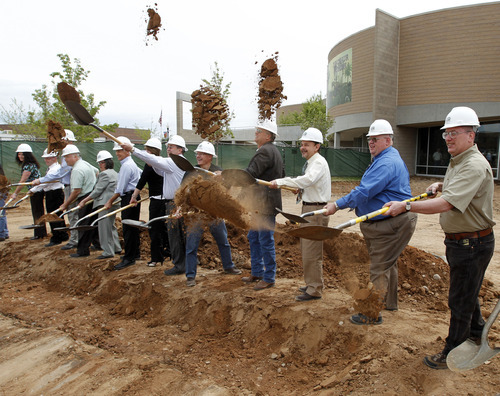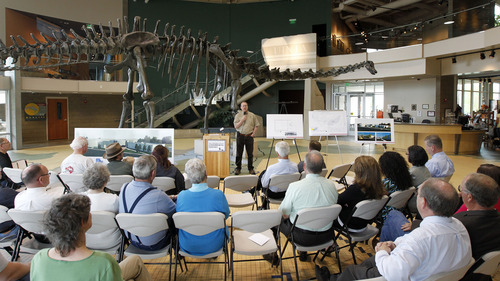This is an archived article that was published on sltrib.com in 2012, and information in the article may be outdated. It is provided only for personal research purposes and may not be reprinted.
Vernal • Residents here created the Utah Field House of Natural History in the 1940s to stem the flow of fossils away from the Uinta Basin by providing space to store the ancient treasures and give locals a place to see artifacts of the dinosaurs that once roamed the region.
That collection, about 30,000 fossils, has been stored in an old building in Vernal since the Field House moved down the highway to new digs in 2004.
On Tuesday, politicians, state employees and residents gathered at the Utah Field House of Natural History State Park Museum for a groundbreaking on a new wing to provide a home for the 30,000 pieces.
"We don't want these fossils hopping on trains and going east," newly named Utah State Parks Director Fred Hayes told the crowd. "A lot of people and groups came together to keep what came from Utah in Utah."
The 11,500-square-foot, state-of-the-art facility is being funded largely by$1.5 million from the Uintah Impact Mitigation Special Service District.
"The energy-extraction industry has discovered many of these artifacts," said Vernal City Councilwoman Sonja Norton, chairwoman of the district, "and isn't it ironic that this energy-resource development also made it possible to build this repository."
Money came from mineral lease fees dedicated to funding industry mitigation projects.
"The old museum is dilapidated and the lease is running out. The community worked hard for several years to solve the problem," Norton said. "It became apparent if we did not do something this year, we would lose the treasures to other places. We are proud to be associated with this public facility and very grateful. It is something we will cherish for years to come."
Field House State Park Manager Steve Sroka confirmed that many of the fossils already on display and in storage were found during oil and gas extraction.
He noted the 30,000 items in storage at the old building will fill only about 10 percent of the addition.
"When people recognize this is a valid place to put and study specimens, we will fill up quickly," he said. "Previously, a lot of this stuff went somewhere else."
Utah State University is committed to using the facility, and Sroka expects other researchers to follow.
"It will be a one-stop deal. They go out in the field, see and collect things, and then they bring it here and prepare and store it," he said. "This is designed to make it easy for researchers and to enhance the visitor experience to the museum."
The new wing is slated for completion in mid-October and will have viewing windows for the public to see work being done on fossils. The museum will remain open during construction.
About the Field House
The Utah Field House of Natural History opened in October 1948 in Vernal.
The current 22,000-square-foot home for the Field House Museum, now a state park, was completed in May 2004.
Exhibits include nearly 3 billion years of earth history.
An outside Dinosaur Garden boasts 17 full-size replicas of prehistoric animals.
The museum houses about 40,000 artifacts and specimens.
Last year, the Field House, once targeted for possible closure, drew nearly 45,000 visitors.
Source: Utah State Parks











